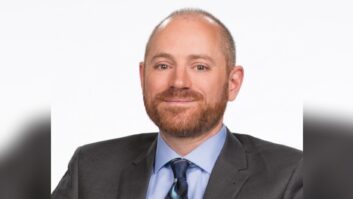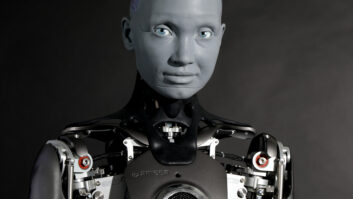Insight on Sessions – NAB2002
Mar 1, 2002 12:00 PM, By Barry Thomas, CPBE CBNT
Saturday April 6
Sunday April 7
Monday April 8
Tuesday April 9
Wednesday April 10
Outside the BEC
Xstream Conference
Each year, the NAB and SBE team up to offer the most concentrated broadcast engineering education opportunity available. Each Spring, the NAB convention hosts the Broadcast Engineering Conference (BEC) which has been the launching point for countless broadcast technologies and new ideas. This year, the BEC offers a rich landscape of engineering issues to explore.

The Saturday, pre-conference sessions of the BEC are typically reserved for workshops and schools, and this year is no exception. SBE and IEEE offer extended workshops that build on real-world broadcast engineering issues.
SBE Broadcast Networking Tutorial, 9a.m. to 4p.m.
This day-long session is presented through the Ennes Educational Foundation Trust. This popular workshop was offered last year and will provide education on computer systems and networks based on the unique needs of todays broadcast installations. Immediately following this program, the SBE will offer testing for its Broadcast Networking Technologist (CBNT) certification. Preregistration is recommended, but on-site registration will be available for the exam period. More information is available at www.sbe.org.
IEEE Streaming for Broadcast Engineers Tutorial, 9a.m. to 4p.m.
This IEEE will include presentations on video and audio content distribution over IP, DTV Datacasting, and a broadcast engineer’s perspective of the process. This session is a highlight of the NAB Xstream conference and is available to full conference registrants.
Broadcast Engineering Conference Opening, 9a.m. to 9:45a.m.
This is one session not to miss. The world watched in horror in September as World Trade Center collapsed. Broadcast engineers mourn not only the lives that were lost but also the one-of-a-kind broadcast transmission facility and those engineers who manned it. Dr. Oded Bendov, one of the original designers of the facility and Patrick Walsh, project manager for the antenna system will be presenting a visual history of the design and installation of the antenna system that was home to 14 NTSC and DTV television stations and four FM stations. The director of the New York/New Jersey Broadcaster’s Coalition, William Baker, will discuss the plans for replacement of the massive facility.
Domestic DAB Developments, 9:45a.m. to 12:15p.m.
This engineering session will be an in-depth look at the state of IBOC and its future. It will include a state-of-the-industry report and technical presentations by the NRSC on adjacent-channel tests, AM and FM lab and field tests, data transmission over IBOC and even audio processing techniques.
Worldwide DAB Developments, 3p.m. to 5p.m.
International sessions often provide valuable insight on broadcast technology and the future of our industry. These sessions comprise a worldwide look at DAB radio and video experiences and research in UK, Canada and Japan. Digital transmission standards and methods will be discussed as well as wireless IP networking, 3G, and broadband network technologies. Expect extensive discussion of IP-based media contribution networks for audio and video digital broadcasting.
The elements of this session will include an update on Digital Radio Mondiale, a DAB update for Japan, a report on integrating 3G wireless and DAB on the Isle of Man and implementing a DAB contribution network using IP.
This mixed set of topics covers real-world situations and problems facing radio stations. The first session, Regulating Antennas and Towers – The Zoning and Siting Wars, deals with a problem many stations encounter when a new tower site is sought. Federal, state and local government agencies and neighborhood associations have restricted antennas and towers with policies that are hardly uniform. The center of the discussion will the National Antenna Consortium’s proposal for a unified national antenna policy.

In Digital Broadcasting Around The World: Real World Experiences, attendees will learn about what is happening with DAB outside the United States. The IBOC Implementation session will provide answers to some of the common questions stations ask about the conversion to IBOC, from the antenna to the transmitter and into the audio chain.
The practical information continues on Tuesday with more sessions designed to help attendees improve their stations’ facilities.
Radio Facilities Engineering Part I, 9a.m. to 12p.m.
Changing ownership and market considerations have initiated the increased modification of radio facilities. This session will involve design considerations and field reports of antenna and FM combiner/master antenna systems but will also include engineering documentation procedures, digital audio wiring, and ISDN/Switched Telco principles.
Radio Facilities Engineering Part II, 1p.m. to 3p.m.
The Tuesday afternoon session will be comprised of presentations that address the future of radio broadcast technology. There will be a presentation on transmission power measurement considerations as well as discussions of advanced program monitoring technologies, interactive radio technologies and the continued convergence of radio and computing technologies.
Radio Transmitters: A Practical Workshop, 3p.m. to 5:30p.m.
This workshop, now a regularly occurring event, offers important, real-world information about transmitter maintenance. This is always a popular and information-filled workshop so you’ll want to arrive early and bring your notebook.
The last day of the Broadcast Engineering Conference includes the annual Technology Luncheon, where the NAB’s Engineering Achievement Award winners receive their awards.
Emergency Preparedness & Security for broadcasters, 9a.m. to11:30a.m.
The current US state of alert has offered another reminder of the importance of the broadcaster in emergency preparedness. The session will provide important preparatory steps for network and broadcast facilities to serve the public and stay on the air during disasters. These technical and management procedures will apply to stations regardless of market or status.
Technology Luncheon, 12:00p.m. to 1:45p.m.
The NAB2002 Engineering Achievement Awards for Radio and Television will be presented at the luncheon. Paul C. Schafer, president of Schafer International, will receive the radio award.
AM Directional Antenna Essentials, 2:00p.m. to 5:00p.m.
This is an essential session for anyone who is responsible for an AM antenna system. Noted AM designers and consultants Benjamin Dawson and Ronald Rackley will present critical information and experiences with directional arrays.
While the Broadcast Engineering Conference is your chance to hone your technical chops, there are other events of note to add to your schedule.
Sunday, April 7, Radio Opening Reception, 4:00p.m. to 5:30p.m.
Start your NAB2002 experience by hooking up with colleagues and new friends in Radio.
Monday, April 8, Cyberjocking: Sound Live Every Time, No MatterWhere You Live, 1:00p.m. to 2:15p.m.
Can you tell the difference between live and voice tracked?
Wednesday, April 10, Amateur Radio Operators Reception, 6:00p.m. to8:00p.m.
Spend a relaxed evening talking shop, swapping tales and enjoying the fellowship of the radio amateur community.
Convergence of radio and streaming technology has required radio engineers to be aware of and, in some cases, fluent in the language of streaming media. The Xtream conference kicks off with the IEEE Streaming Media Supersession on Saturday (outlined previously) and continues with sessions on successful website operations, IP multicast and a complete overview of the convergence of the broadcasting and online worlds.

Indeed this year’s NAB conferences will offer a wealth of education for the broadcast engineer with available exposure to important emerging technologies. Of course I recommend you make a point and enjoy the NAB experience further and get tickets to Jay Leno’s one-night-only performance at the Bellagio on Sunday night, April 7. Full-conference registrants receive $25.00 off the admission for this unique performance just for broadcasters.
I encourage you to visit the NAB website, www.nab.org, and click on the Conventions and Conferences sections to explore the complete program and schedule your days before you attend. Your full conference registration will give you access to any of these sessions. SBE members receive the NAB-member registration rate, which can save significant money over non-NAB-member fees.
Don’t forget to allow plenty of exhibit floor time to see the new technology available for your stations!
Thomas is chief technology officer of StratosAudio, Los Angeles.












